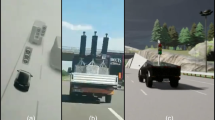Abstract
Detecting, locating and repairing faults is a hard task. This holds especially in cases where dependent failures occur in practice. In this paper we present a methodology which is capable of handling dependent failures. For this purpose we extend the model-based diagnosis approach by explicitely representing knowledge about such dependencies which are stored in a failure dependency graph. Beside the theoretical foundations we present algorithms for computing diagnoses and repair actions that are based on these extensions. Moreover, we introduce a case study which makes use of a larger control program of an autonomous and mobile robot. The case study shows that the proposed approach can be effectively used in practice.
Similar content being viewed by others
References
Steinbauer G, Wotawa F (2005) Detecting and locating faults in the control software of autonomous mobile robots. In: Proceedings of the 19th international joint conf on artificial intelligence, Edinburgh, UK, pp 1742–1743
Peischl B, Weber J, Wotawa F(2006) Runtime fault detection and localization in component-oriented software systems. In: Proceedings of the 17th international workshop on principles of diagnosis (DX-06), Peñaranda de Duero, Spain, June 2006
Weber J, Wotawa F (2006) Using AI techniques for fault localization in component-oriented software systems. In: Proceedings of the 5th Mexican international conference on artificial intelligence (MICAI 2006), Apizaco, Mexico, November 2006
Weber J, Wotawa F (2007) AI-planning in a mobile autonomous robot with degraded software capabilities. In: International workshop on moving planning and scheduling systems into the real world, Providence, Rhode Island, USA, 2007. At ICAPS’07
Reiter R (1987) A theory of diagnosis from first principles. Artif Intell 32(1):57–95
de Kleer J, Williams BC (1987) Diagnosing multiple faults. Artif Intell 32(1):97–130
de Kleer J, Mackworth AK, Reiter R (1992) Characterizing diagnoses and systems. Artif Intell 56(2–3):197–222
Weber J, Wotawa F (2007) Diagnosing dependent failures in the hardware and software of mobile autonomous robots. In: Proceedings of the 20th international conference on industrial, engineering and other applications of applied intelligent systems (IEA/AIE 2007), Kioto, Japan, June 2007
Weber J, Wotawa F (2007) Diagnosing dependent failures—an extension of consistency-based diagnosis. In: 18th International workshop on principles of diagnosis (DX-07), Nashville, USA, 2007
Weber J, Wotawa F (2008) Dependent failures in consistency-based diagnosis. In: 18th European conference on artificial intelligence (ECAI 2008), pp 801–802, Patras, Greece
Hamscher W, Console L, de Kleer J (ed) (1992) Readings in model-based diagnosis. Morgan Kaufmann, San Mateo
Struss P, Dressler O (1989) Physical negation: Integrating fault models into the general diagnostic engine. In: Proceedings of the 11th international joint conf on artificial intelligence, pp 1318–1323
Friedrich G, Gottlob G, Nejdl W (1990) Physical impossibility instead of fault models. In: Proceedings of the national conference on artificial intelligence (AAAI). Also appears in Readings in Model-Based Diagnosis (Morgan Kaufmann, San Mateo 1992)
Davis R, Hamscher W (1988) Model-based reasoning Troubleshooting. In: Shrobe HE (ed) Exploring artificial intelligence. Morgan Kaufmann, San Mateo, pp 297–346, Chap. 8
Böttcher C (1995) No faults in structure? How to diagnose hidden interactions. In: IJCAI, pp 1728–1735
Steinbauer G, Mörth M, Wotawa F (2005) Real-time diagnosis and repair of faults of robot control software. In: Proceedings of the international RoboCup symposium, Osaka, Japan, 2005
de Kleer J (1990) Using crude probability estimates to guide diagnosis. Artif Intell 45:381–392
de Kleer J, Williams BC (1989) Diagnosis with behavioral modes. In: Proceedings of the 11th international joint conf. on artificial intelligence, pp 1324–1330
Minoux M (1988) LTUR: A simplified linear-time unit resolution algorithm for Horn formulae and computer implementation. Inf Process Lett 29:1–12
Grosclaude I (2004) Model-based monitoring of software components. In: Proceedings of the 16th European conference on artificial intelligence. IOS, Amsterdam, pp 1025–1026. Poster
Ardissono L, Console L, Goy A, Petrone G, Picardi C, Segnan M, Duprè DT (2005) Cooperative model-based diagnosis of web services. In: Proceedings of the 16th international workshop on principles of diagnosis, DX workshop series, pp 125–132, June 2005
Mayer W, Stumptner M (2003) Extending diagnosis to debug programs with exceptions. In: Proceedings of the 18th IEEE international conference on automated software engineering (ASE). Montreal, Quebec, Canada. IEEE Press, New York
Köb D, Wotawa F (2004) Introducing alias information into model-based debugging. In: 16th European conference on artificial intelligence (ECAI), Valencia, Spain, August 2004. IOS, Amsterdam, pp 833–837
Mikaelian T, Williams BC (2005) Diagnosing complex systems with software-extended behavior using constraint optimization. In: Proceedings of the 16th international workshop on principles of diagnosis, DX workshop series, pp 125–132
Garlan D, Schmerl B (2002) Model-based adaptation for self-healing systems. In: WOSS’02: Proceedings of the first workshop on self-healing systems. Assoc Comput Mach, New York, pp 27–32
Roos N, Witteveen C (2005) Diagnosis of plans and agents. In: Proceedings of the 4th international Central and Eastern European conference on multi-agent systems (CEEMAS)
Lucas PJF (2001) Bayesian model-based diagnosis. Int J Approx Reason 27(2):99–119
Davis R (1984) Diagnostic reasoning based on structure and behavior. Artif Intell 24:347–410
Preist C, Welham B (1990) Modelling bridge faults for diagnosis in electronic circuits. In: Proceedings of the first international workshop on principles of diagnosis, Stanford
Author information
Authors and Affiliations
Corresponding author
Additional information
This research has been funded in part by the Austrian Science Fund (FWF) under grant P20199-N15.
Rights and permissions
About this article
Cite this article
Weber, J., Wotawa, F. Diagnosis and repair of dependent failures in the control system of a mobile autonomous robot. Appl Intell 36, 511–528 (2012). https://doi.org/10.1007/s10489-008-0143-x
Received:
Accepted:
Published:
Issue Date:
DOI: https://doi.org/10.1007/s10489-008-0143-x




